
QI GONG EXERCISES
If a man knows the method to nourish the breath, he is able to become an immortal.
TAO TSANG, Taoist Canon (translated by Jane Huang)
Looking at pictures of exercises in a book is not the ideal way to learn in this modern age of web streaming. Actually, no media format is ideal for learning qi gong, as these traditions have been passed down through direct transmission over thousands of years. In fact, my grand master prohibits the use of video cameras with the Taoist nei gong system of our lineage, where oral and personal transmissions are the only means allowed. Other traditions are a bit more lax. Moving sequenced sets are obviously harder to illustrate in a book than standing or seated static exercises, but the real key is to convey the work accurately so that the reader can learn it and practice correctly.
In light of this, after a good deal of thought and meditation, I have developed a program that I feel addresses the fundamentals of practice and really sets things up correctly for your energy practice. You will learn three traditional exercises in this chapter that will get you well on your way to better health, stamina, and energy flow.
I want nothing less than complete transformation for you. Holding that thinking in mind, it is important for you to practice all the exercises in this book. This means the physical practice (diet, exercise, sleep, and basic lifestyle modification); the qi gong practice in this chapter (all three exercises); and the mental, emotional, and spiritual practices that follow. I have boiled energy cultivation down into a cohesive and effective system; all it takes is for you to plug into it. You do the work, and you reap the rewards. The formula is that easy.
EXERCISE 1
The Silk Weaver’s Exercise (Wei Gong/Qi Gong)
This particular sequence is a health set that helps open up and dilate the meridians. It is of Buddhist origins and has been taught for years as the quintessential health set of the qi gong tradition. It is to be done three times — two moving repetitions and one with the eyes closed doing the entire thing through visualization.
This set is a moving set; in order to preserve the integrity of the motions, I’d like for you to go to the following link to see it: SoundsTrue.com/inner-alchemy/bonus. This site provides unlimited free access for you to view the exercise to make sure you are doing it correctly. All the fundamentals are important for this exercise, including having the tip of the tongue touch the roof of the mouth and having a feeling of heaviness in the lower body. Please spend some time learning this and burning it into your body’s memory so you can practice it anywhere you may be.
Learning sequenced movements is an important practice that not only makes you more aware but also helps develop the brain and nervous system.
EXERCISE 2
The Shaolin Standing Form (Qi Gong/Strength Building)
This set comes from the Shaolin tradition and is incredibly challenging at first for many people, as most people in the modern age have weak postural muscles and are not accustomed to deep lower abdominal breathing. These deep stances help build resolve and help develop a powerful connection with the lower dantien. The hand postures help open energy flow through the shoulders (where many of us have trapped energy) and through axillary arteries.
Try to stay in these stances for a designated amount of time and try to maintain your stances consistently. This may be difficult at first, but you will quickly find that you can do more and more with sustained practice. It is okay to feel challenged in your leg muscles, but do not force your way through joint pain. You can turn your feet slightly outward if your knees bother you. Keep the tongue touching the roof of the mouth, and breathe in and out of the lower abdomen for all the exercises taught henceforth.
If you begin to feel light-headed during the early stages of this practice, it is likely due to the massive energy reserves being released. Just have a seat and begin again when you’ve gained your composure. It is perfectly natural to feel a rush of energy rise to the head during this exercise.
Since this is a static exercise, examine each posture individually in this section. Pick a designated amount of time to stay in each posture and increase the time as your proficiency develops. Thirty seconds to a minute per posture is enough for most people when they start. Try to add thirty seconds per posture per week if you can, as this will quickly propel you into a very strong practice. The energy that gets freed up in your system will feel great and will serve as an encouragement to keep practicing.
OPENING STANCE SQUARE HORSE
Stand with even weight distribution between both legs. Keep your head up straight with your hands at waist level.

STANCE 1 PALMS UP, RESISTING UPWARD
Imagine a very heavy weight on top of each palm. Resist to keep them up.
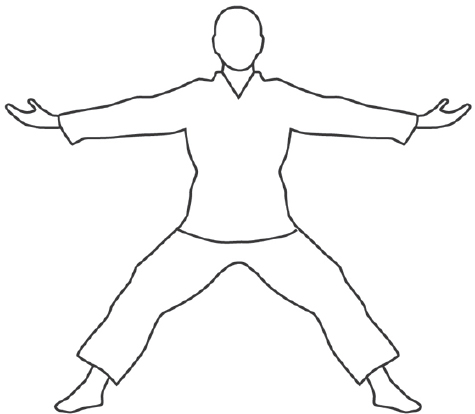
STANCE 2 PALMS DOWN, RESISTING DOWNWARD
Imagine a force pushing up from the earth against your palms. Work to stay in position.
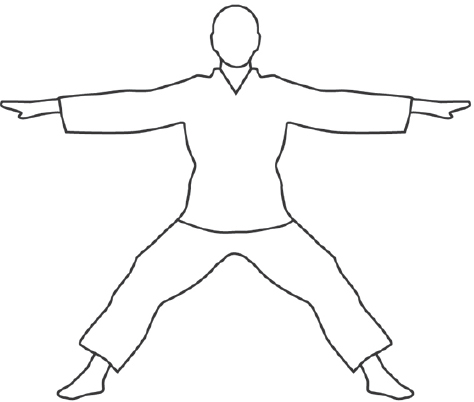
STANCE 3 FINGERTIPS UP, PRESSING OUTWARD
Now the imaginary force is coming in from the sides, like elevator doors closing. Hold outward.

STANCE 4 PALMS UP, PRESSING AGAINST THE SKY
Now the imaginary force is bearing down on you. Use dynamic tension to resist against it.
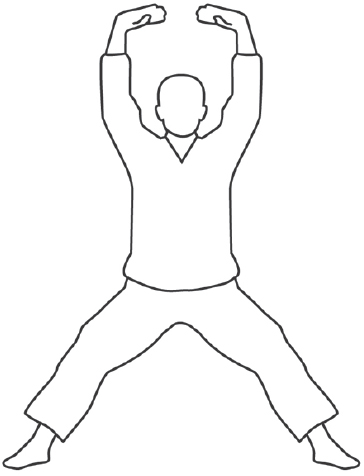
STANCE 5 PALMS DOWN, POURING ENERGY INTO THE HEAD
Let your palms rain energy back down onto your head and body.
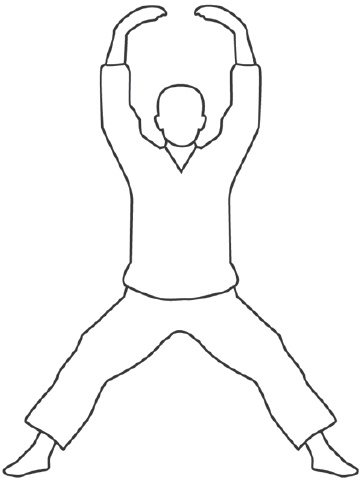
STANCE 6 PALMS FACING CHEST, GATHERING ENERGY IN THE HEART
Feel the energy swirl between your palms and your torso. Gather energy into your heart.
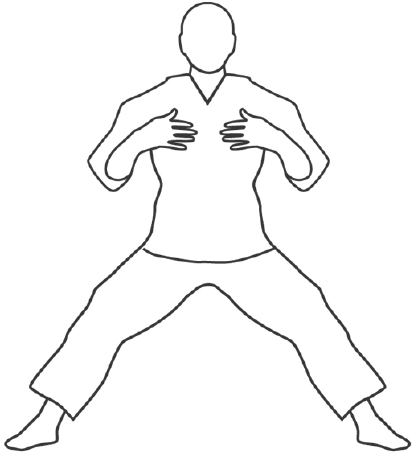
STANCE 7 PALMS FLAT BEHIND BACK WITH FINGERS POINTING FORWARD AND PALMS FACING DOWN, CONNECTING WITH THE GROUND
Round out the elbows as you feel your kidneys fill up with energy. Resist a force pushing up from the earth with palms flat.
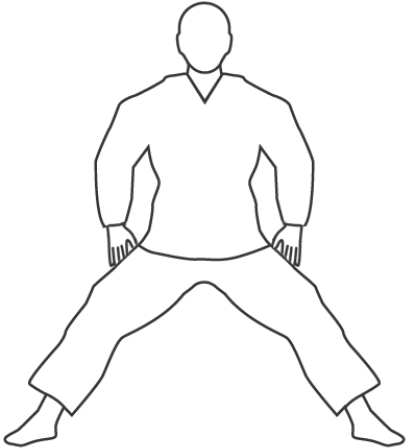
STANCE 8 PALMS TOGETHER, GATHERING ENERGY IN THE HEART
Rest in prayer position and allow the energy to gather in your heart.
As I mentioned, this series of exercise is from the Shaolin kung fu tradition. It is “hard work,” which is a wonderful thing, as it creates a good habit of allowing you to push through certain blockages and trains you to deal with muscle pain (and burning!) with equanimity. Remember, Shaolin is the birthplace of the Zen tradition. When you put this art into actual practice, it is the physical body’s reflection of the mental practice of nonreacting to aversions and cravings. The Shaolin system trains the “bodymind” as a unified complex; proficiency in this training leads to excellent meditation skills.

EXERCISE 3
The Triple Burner Exercise (Wei Gong/Qi Gong)
This exercise uses a series of dynamic standing postures with breathwork, just like the previous exercise, but it also incorporates another layer of sophistication, which is the practice of guided visualization. The triple burner exercise is an effective health set that teaches you to use your shen to guide your energy to certain places within the body. With sustained focus, you will learn to heal yourself and to bring the light of awareness to different body parts. This is your first venture in guiding qi internally; the mastery of this principle will allow you to move into higher principles of nei gong.
BASIC STANCE
Stand in a basic wu chi posture: The feet are shoulder-width apart. The hands are off to the sides with a bit of space under each armpit, palms facing behind you. This practice uses what is called “four point” balancing, where you balance your weight on the balls and heels of each foot. Touch the tip of the tongue to the roof of the mouth and breathe in nose and out nose to the lower dantien.
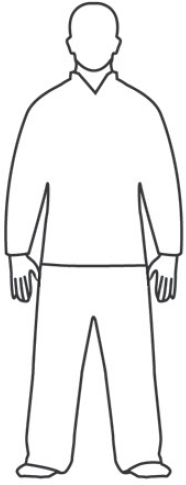
Organs to clear: heart, lungs, pericardium, glands in the throat
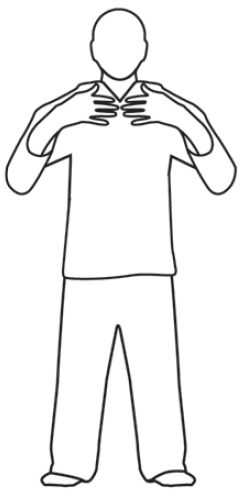
• Hold your hands in the “tree” position up in front of your chest.
• Keep breathing in nose and out nose to the lower dantien.
• Stay with your four-point stance throughout this entire exercise.
• Start breathing to your palms and feel a white light emanating from the center of your palms into your upper chest.
• Simultaneously, reflect this light back from the upper chest to push against your palms.
• Feel the exchange of energy between the palms and the chest. Shift your attention to this area but keep breathing to the lower dantien.
• Stay here in this posture until you feel that all the energy in this region is fully cleared before moving to the next posture. When you can sense only clean energy and white light, that is when you’re done.
POSTURE 2 MIDDLE BURNER
Organs to clear: stomach, spleen, liver, gallbladder, upper intestine, pancreas
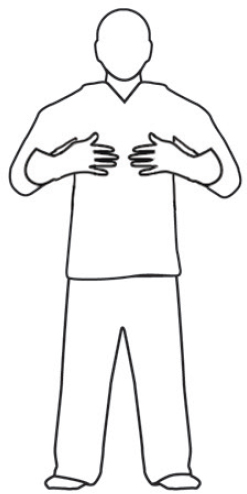
• Move your hands slightly lower to the level of the lower sternum.
• Continue the same practice as in the first posture, until you feel that this level is completely clear of any blockages.
• Remember to inundate the area with pure white light and to really focus on the exchange between the palms and the torso.
POSTURE 3 LOWER BURNER
Organs to clear: kidneys (in the back), bladder, intestines, sexual organs

• Move your hands slightly lower to the level of the navel.
• Continue the same practice until you feel that this level is completely clear of any blockages.
• Really focus and clear as many energetic blockages as you can find in the gut region.
POSTURE 4 KIDNEYS
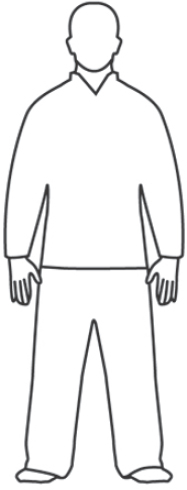
• Move your hands behind the back with palms flat and facing the ground behind the kidneys.
• Connect the light coming from your palms with the earth.
• On the inhale (in nose), visualize liquid white light coming up from your feet and your palms all the way to the crown of your head.
• On the exhale (out nose), push this energy back down into the earth through the palms and feet.
INHALE UP FEET TO HEAD AND INTO FINGERS.
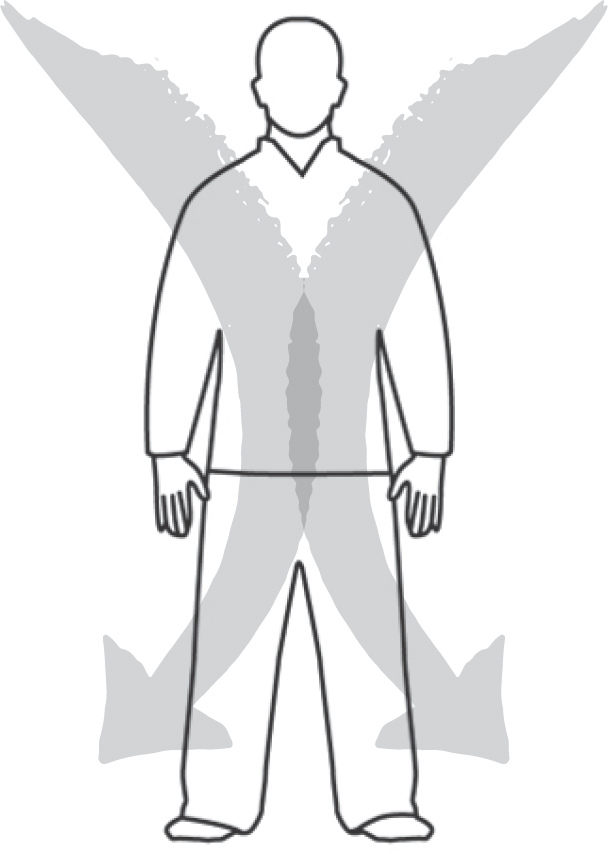
EXHALE DOWN FROM HEAD AND ARMS INTO EARTH THROUGH FEET.
• Continue to draw energy up to the crown on the inhale and back down into the earth on the exhale for several breaths.
• When you feel like your body is free and clear of any blocked energies, take a long exhale out of the mouth and move to the closing sequence.
CLOSING SEQUENCE SELF-MASSAGE
• Rub from the backs of your shoulders (one at a time) down the outside of the arm to the pinky with the opposite hand and then back up the thumb side into the chest.
• Circle and rub your heart region and then your lower dantien.
• Rub your kidney region on your back with both palms.
• Rub down the backs of both legs while bending forward and then rub up the front while standing upright again.
• Tap your lower dantien (three finger-widths below your navel) three times with both hands.
With continued practice of this set, you will develop clarity of mind and a clean energy field. This is a critical skill to help you grow and understand your essential nature. When you stop identifying with the “noise” and clean your energy field, you become more and more aware of who you truly are. This is one of the most liberating things you can do for yourself.
Sequencing
In an ideal situation, it would be best to practice exercises 1 and 2 in the morning (outdoors in fresh air if possible) at least thirty to sixty minutes after a short walk to get the blood moving but before breakfast. Yes, this means getting up earlier, but the benefits are simply priceless. Exercise 3 can be done at any point throughout the day but preferably before 9:00 p.m. Do not perform exercise 3 too close to bedtime as it may stimulate you too much and cause insomnia. It is actually a great exercise to do around 3:00 or 4:00 p.m., when your energy may start to fade. Just a few minutes in a short set is better than nothing, and you’ll feel great. Play with it and see what works best for you.
Qi Gong Rule: Do not eat sixty minutes before training and at least thirty minutes after training. This may be difficult in the mornings especially, but it is important to observe. Here’s what I have done for years: I wake up, go for a run or brisk walk, do my practice for thirty minutes or so, then jump in the shower and go through my preparatory morning routine. By then, I’m ready to eat anyhow, and things have settled. When you are ready, eat a healthy breakfast and be on your way.
If you make it a point to get all three exercises in every day, you will start to feel a profound difference very quickly. It is important to note that a great deal of stagnant and trapped energy will be released throughout this process. Some people feel dizzy and/or light-headed in the first couple of weeks (especially in exercise 2). Take it slowly and work your way up to greater difficulty. More time and deeper stances are where you should aim to be, but all within reason. Remember, Taoism is about balance. There’s good stress and unhealthy stress on the system. You want to walk that razor’s edge and stay right in the middle — pushing yourself to evolve and grow without overstepping your limits. When you commit to making it your daily practice, the pressure is off, and you can keep moving the marker forward every day.
A good example of this steady progress is kung fu high-jumping training. When a young monk starts his training, he is given a baby stalk of corn to plant and care for. His assignment is to jump over this stalk ten times daily with both feet. He does this religiously for months on end until he realizes that he is clearing a few feet with a vertical jump! This is how your practice will progress. Follow the instructions carefully and integrate the exercises from this chapter in order to make the training complete. Remember, you don’t want to “pick and choose” what’s most convenient for you, because that usually implies that you are acting out of trance and avoiding something that makes you uncomfortable.